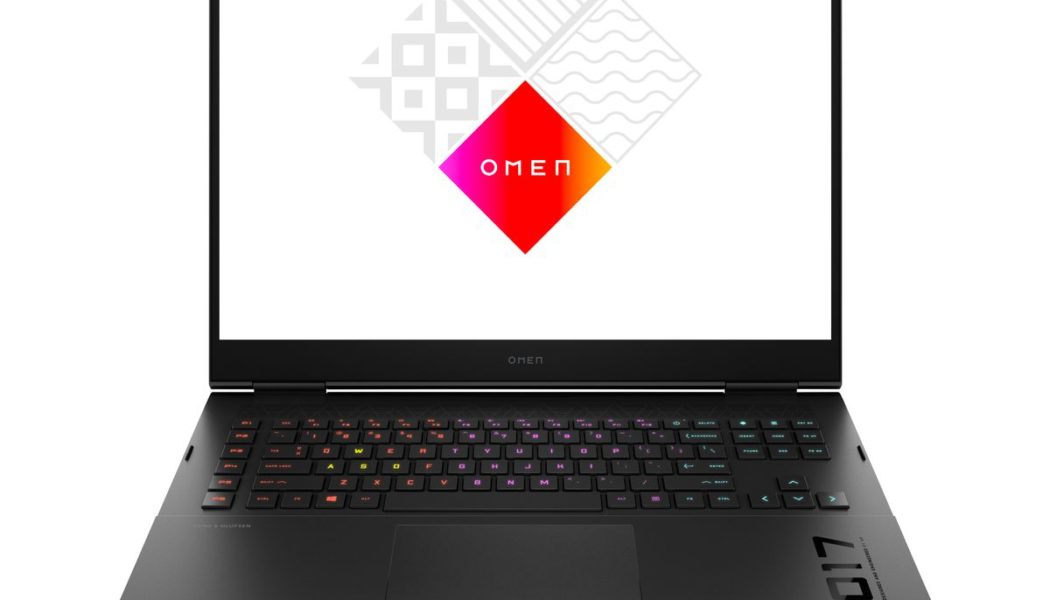HP made an almost overwhelming bunch of gaming announcements today, which include systems equipped with Intel’s 11th Gen H-series processors: a new 16-inch Omen gaming laptop and an updated 17-inch version, along with a new budget-friendly gaming laptop line called Victus. There is also a new Nvidia G-Sync-compatible monitor. Other major tech companies — such as Razer, Lenovo, MSI, and Asus — debuted their H-series-equipped laptops last week, but HP saved its news for now.
The Omen 16 (pictured above) has a 16.1-inch display and can be configured with up to QHD resolution using a fast 165Hz refresh rate. It’s got a 16:9 aspect ratio display (disappointing, since Lenovo and Asus have competing models offering the more spacious 16:10 aspect ratio). You’ll be able to choose between AMD and Intel’s latest processors for this model, up to an AMD Ryzen 7 5900HX or an Intel Core i7-11800H, and each tops out at the RTX 3070 in the graphics department.
If you run with Intel and get at least the RTX 3060 for graphics, you’ll get a Thunderbolt 4 port as part of the deal. Otherwise, both the AMD and Intel models share some highlights in common, including an SD card slot and an HDMI 2.1 port for up to 4K output at 120Hz on supported displays. The Omen 16 can ship with a maximum of 32GB of DDR4 RAM clocked at 3,200MHz, and its battery tops out at an 83Wh capacity.
The AMD and Intel models differ when it comes to how they handle storage. Both can have up to a 1TB NVMe M.2 SSD, but on the Intel configuration, the SSD runs at PCIe 4.0 speeds and has dual slots for RAID 0 storage. The AMD model is limited to PCIe 3.0 speeds, but that should still be fast enough for most people.
HP has only shared the prices for the starting models of the Omen 16. The AMD model with a Ryzen 7 5800H processor, an Nvidia RTX 3050 Ti graphics chip, 16GB of RAM, and 512GB of storage, will cost $1,049.99. The Intel version that has the Core i7-11800H processor with the same storage and RAM, but with the RTX 3060 graphics chip, will cost $1,149.99. The Omen 16 is set to ship in June.
:no_upscale()/cdn.vox-cdn.com/uploads/chorus_asset/file/22525791/omen17.jpg)
HP’s Omen 17 is a bigger, more powerful gaming laptop that isn’t as configurable when it comes to processors. This model supports Intel only, going up to the Intel Core i9-11900H. You can get it with Nvidia’s RTX 3080 graphics chip powered at 165W and with up to 16GB of video memory, which should ensure great gaming performance at QHD resolution. Its 17.3-inch display can be bumped up to QHD resolution at a 165Hz refresh rate, just like the Omen 16. This laptop starts at $1,369.99 and will also ship in June.
:no_upscale()/cdn.vox-cdn.com/uploads/chorus_asset/file/22525781/victus16.jpg)
A new addition to HP’s lineup of gaming laptops is the Victus, a more budget-friendly 16-inch model, also available in June, that will cost $849.99 with an Intel processor or $799.99 with an AMD processor. You’ll be able to configure this one’s processor and graphics up to Intel’s Core i7-11800H or AMD’s Ryzen 7 5800H processors, with up to Nvidia’s RTX 3060 or AMD’s Radeon RX 5500M GPUs.
Memory and storage for the Victus is the same as for the Omen 16. You’ll be able to upgrade the Victus’ 16.1-inch display to QHD resolution at a 165Hz refresh rate, and the chassis comes in multiple colors (white, blue, or black). However, while HP talks a big game about the Omen 16 and Omen 17 having better airflow than before, resulting in lower running temperatures while gaming, the Victus might fall behind the more pricey Omen laptops in the cooling department. We won’t know how the Victus handles heat until we try it out ourselves.
:no_upscale()/cdn.vox-cdn.com/uploads/chorus_asset/file/22525788/omen25i.jpg)
Lastly, HP’s Omen 25i gaming monitor will cost $349.99 when it launches in July. It’s a 24.5-inch FHD IPS monitor that has slim bezels and adaptive sync to eliminate visual artifacts in games with AMD’s FreeSync Premium Pro and Nvidia G-Sync technology. Other notable features include a 165Hz refresh rate, 1ms response time, and a color-accurate picture with 90 percent coverage of the DCI-P3 gamut.
HP has included some interesting features with this monitor, like a “Game Remaster” mode that uses filters to smooth over games that haven’t aged well and usually have jagged graphics. More impressive is its “Dynamic Crosshair” feature that can change color dynamically in order to remain easily visible when the contrast of your game’s scene changes. For games in which you’re going in and outdoors a lot, this could make a big difference.









